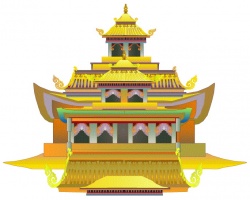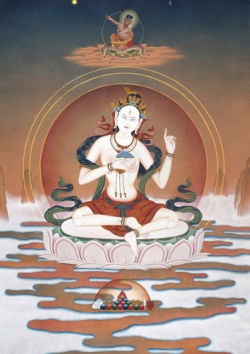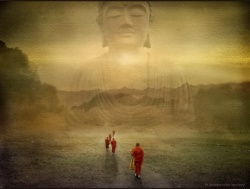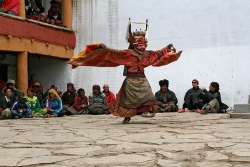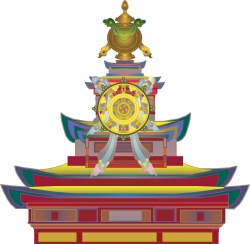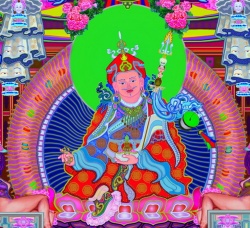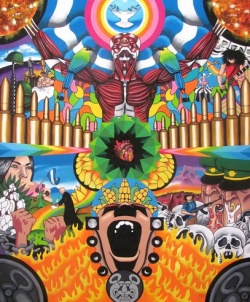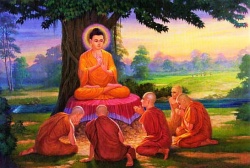Difference between revisions of "Kalsang Monastery"
(Created page with "{{BigTibetan|སྐལ་བཟང་དགོན།}}<br> skal bzang dgon<br> nyag rong shar rgyal ba skal bzang dgon<br> ---- '''SETTING FOR KALSANG MONASTERY'''...") |
m (Text replacement - "]]]" to "]])") |
||
| (3 intermediate revisions by 2 users not shown) | |||
| Line 1: | Line 1: | ||
| + | {{DisplayImages|9|93|1598|968|371|1462|1727|1334}} | ||
{{BigTibetan|[[སྐལ་བཟང་དགོན།]]}}<br> | {{BigTibetan|[[སྐལ་བཟང་དགོན།]]}}<br> | ||
[[skal bzang dgon]]<br> | [[skal bzang dgon]]<br> | ||
| Line 4: | Line 5: | ||
---- | ---- | ||
'''SETTING FOR KALSANG MONASTERY'''<br> | '''SETTING FOR KALSANG MONASTERY'''<br> | ||
| − | What follows is a brief historical account of the Victorious Eastern Kalsang Sangye Choling (the | + | What follows is a brief historical account of the [[Victorious Eastern Kalsang Sangye Choling]] (the [[thousand Buddhas of virtuous kalpa]], [[bsKal-bZang Sangs-rGyas Chos-kLing]]) , abode of the Great [[Secret Mantra]] [[Early Translation School]] of the [[Clear Light]] [[Great Perfection]]. <br> |
| + | |||
<br> | <br> | ||
| − | This [[monastery]] is situated in the lower region of [[Dokham]] (the composed [[name]] of [[Amdo]] and [[Kham]], the whole of [[East Tibet]], mDo-Khams) in the Snowland of [[Tibet]], in the center of the [[Nyak | + | This [[monastery]] is situated in the lower region of [[Dokham]] (the composed [[name]] of [[Amdo]] and [[Kham]], the whole of [[East Tibet]], [[mDo-Khams]]) in the Snowland of [[Tibet]], in the center of the [[Nyak Adzi Rong]] ([[Nyag-A-‘Dzi-Rong]]), a valley of {{Wiki|medicinal}} herbs.<br> |
<br> | <br> | ||
| − | This place, surrounded by natural [[beauty]] and grace, is known as [[Shanglang Drakar]] ([[Shang-Lang-Brag-dKar]]), White Boulder Sword, or [[Ne LhangLhang Norbu Yantse]] ([[gNas-Lhang-Lhang-Nor-Bu-Yang-rTse]]), [[Sacred | + | |
| + | This place, surrounded by natural [[beauty]] and grace, is known as [[Shanglang Drakar]] ([[Shang-Lang-Brag-dKar]]), White Boulder Sword, or [[Ne LhangLhang Norbu Yantse]] ([[gNas-Lhang-Lhang-Nor-Bu-Yang-rTse]]), [[Sacred Place of Clear Sound]], [[Crest of the Jewel]]. <br> | ||
<br> | <br> | ||
| + | |||
In [[Sangye Lingpa]] ([[Sangs-rGyas-gLing-Pa]])’s Prophetic Account of [[Sacred]] Places, he writes, <br> | In [[Sangye Lingpa]] ([[Sangs-rGyas-gLing-Pa]])’s Prophetic Account of [[Sacred]] Places, he writes, <br> | ||
<br> | <br> | ||
| Line 15: | Line 19: | ||
Among these, the [[Sacred]] Place of Clear [[Sound]] is like an [[Udumbara]]."<br> | Among these, the [[Sacred]] Place of Clear [[Sound]] is like an [[Udumbara]]."<br> | ||
<br> | <br> | ||
| + | |||
Also, in the Great [[Saint]] [[Pema]] Duddul ([[Pad-Ma-bDud-‘Dul]])'s [[Prophesy]] of [[Hidden Treasures]], he writes, <br> | Also, in the Great [[Saint]] [[Pema]] Duddul ([[Pad-Ma-bDud-‘Dul]])'s [[Prophesy]] of [[Hidden Treasures]], he writes, <br> | ||
<br> | <br> | ||
| + | |||
"In the wondrous southern [[sphere]] in the [[East]] of the [[Land of Snows]],<br> | "In the wondrous southern [[sphere]] in the [[East]] of the [[Land of Snows]],<br> | ||
<br> | <br> | ||
| + | |||
In the [[hidden land]] between Mount Rongchen ([[Rong-Chen]])<br> | In the [[hidden land]] between Mount Rongchen ([[Rong-Chen]])<br> | ||
and Mount Borragang ([[‘Bor-Ra-sGang]]),<br> | and Mount Borragang ([[‘Bor-Ra-sGang]]),<br> | ||
<br> | <br> | ||
| − | A conch-colored {{Wiki|crystal}} rock pierces the sky known as Sword Boulder or<br> | + | A conch-colored {{Wiki |
| + | |crystal}} rock pierces the sky known as Sword Boulder or<br> | ||
White Boulder Sky Fortress or especially as [[Jewel]] Crest of Clear [[Sound]].<br> | White Boulder Sky Fortress or especially as [[Jewel]] Crest of Clear [[Sound]].<br> | ||
<br> | <br> | ||
| + | |||
There dwells the [[inconceivable]] [[divine]] assembly of [[gods]] and [[deities]].<br> | There dwells the [[inconceivable]] [[divine]] assembly of [[gods]] and [[deities]].<br> | ||
<br> | <br> | ||
There the three [[divine]] [[protectors]] ([[Manjusri]], [[Avalokitesvara]] and [[Vajrapani]]),<br> | There the three [[divine]] [[protectors]] ([[Manjusri]], [[Avalokitesvara]] and [[Vajrapani]]),<br> | ||
the [[Second Buddha]] ([[Guru]] [[Padma Sambhava]]) and many others have<br> | the [[Second Buddha]] ([[Guru]] [[Padma Sambhava]]) and many others have<br> | ||
| − | performed innumerable miraculous displays of [[accomplishment]]. <br> | + | performed {{Wiki|innumerable}} miraculous displays of [[accomplishment]]. <br> |
<br> | <br> | ||
| + | |||
Merely [[seeing]], hearing, recalling or [[touching]] this<br> | Merely [[seeing]], hearing, recalling or [[touching]] this<br> | ||
place brings one to complete [[realization]]. <br> | place brings one to complete [[realization]]. <br> | ||
<br> | <br> | ||
It is a {{Wiki|holy}} place where the [[rainbow body]]<br> | It is a {{Wiki|holy}} place where the [[rainbow body]]<br> | ||
| − | and [[dakini's]] [[heaven]] can be attained." <br> | + | and [[dakini's]] [[heaven]] can be [[attained]]." <br> |
<br> | <br> | ||
| + | |||
The wondrous landscape is adorned with much great natural [[beauty]]. The three [[divine]] [[protectors]] and the Three Ancestral [[Spiritual]] [[Kings]], [[Master]] [[Padma Sambhava]], the [[Great Translator]] [[Vairochana]], [[Dakini]] [[Yeshe Tsogyal]] ([[Ye-Shes-mTsho-rGyal]]), [[Nyangwen Tingdzin Sangpo]] ([[Nyang-Ban-Ting-‘Dzin-bZang-Po]]) and others personally stepped upon this land, miraculously concealed treasure-teachings, subjugated the local [[gods]] and [[spirits]] and made them [[protectors]] of this [[sacred]] place.<br> | The wondrous landscape is adorned with much great natural [[beauty]]. The three [[divine]] [[protectors]] and the Three Ancestral [[Spiritual]] [[Kings]], [[Master]] [[Padma Sambhava]], the [[Great Translator]] [[Vairochana]], [[Dakini]] [[Yeshe Tsogyal]] ([[Ye-Shes-mTsho-rGyal]]), [[Nyangwen Tingdzin Sangpo]] ([[Nyang-Ban-Ting-‘Dzin-bZang-Po]]) and others personally stepped upon this land, miraculously concealed treasure-teachings, subjugated the local [[gods]] and [[spirits]] and made them [[protectors]] of this [[sacred]] place.<br> | ||
<br> | <br> | ||
For the sake of the [[propagation]] of the [[Buddha’s]] [[doctrine]] and the [[happiness]] of all [[sentient beings]] and the [[people]] of [[Tibet]] in particular, a profusion of great [[deeds]] were performed. There is a self-arisen image of [[Guru Rinpoche]] in the famous [[form]] known as "Overwhelming the [[Universe]] with Glorious Lustre" and a footprint of [[King Ling Gesar's]] ([[gLing-Ge-Sar]]) [[horse]].<br> | For the sake of the [[propagation]] of the [[Buddha’s]] [[doctrine]] and the [[happiness]] of all [[sentient beings]] and the [[people]] of [[Tibet]] in particular, a profusion of great [[deeds]] were performed. There is a self-arisen image of [[Guru Rinpoche]] in the famous [[form]] known as "Overwhelming the [[Universe]] with Glorious Lustre" and a footprint of [[King Ling Gesar's]] ([[gLing-Ge-Sar]]) [[horse]].<br> | ||
<br> | <br> | ||
| + | |||
The saintly father and son, [[Lord]] [[Marpa]] and [[Milarepa]], came to this place by [[mystical]] means, and the {{Wiki|cave}} where they stayed, called Valley of the Cotton Clad ([[Ras-gShong]]), can still be seen today. A [[stupa]] called "Vanquishing the Proud [[Spirit]]", a [[stupa]] built by [[Vairochana]] and a [[stupa]] built by [[Garwa Tongtsan]] are all built around or nearby the [[monastery]].<br> | The saintly father and son, [[Lord]] [[Marpa]] and [[Milarepa]], came to this place by [[mystical]] means, and the {{Wiki|cave}} where they stayed, called Valley of the Cotton Clad ([[Ras-gShong]]), can still be seen today. A [[stupa]] called "Vanquishing the Proud [[Spirit]]", a [[stupa]] built by [[Vairochana]] and a [[stupa]] built by [[Garwa Tongtsan]] are all built around or nearby the [[monastery]].<br> | ||
<br> | <br> | ||
| Line 48: | Line 60: | ||
thus by the eight [[directions]]:<br> | thus by the eight [[directions]]:<br> | ||
<br> | <br> | ||
| + | |||
To the [[East]], all the [[mountains]] are white and smooth, a sign<br> | To the [[East]], all the [[mountains]] are white and smooth, a sign<br> | ||
of the absence of {{Wiki|illness}}, [[evil]] and fearsome [[spirits]].<br> | of the absence of {{Wiki|illness}}, [[evil]] and fearsome [[spirits]].<br> | ||
| Line 57: | Line 70: | ||
victory over the [[three realms]] and the [[three worlds]].<br> | victory over the [[three realms]] and the [[three worlds]].<br> | ||
<br> | <br> | ||
| + | |||
The northern [[mountains]] are high, rugged and ominous, a sign of<br> | The northern [[mountains]] are high, rugged and ominous, a sign of<br> | ||
completely expelling all enemy [[delusions]] and hindrance-causing {{Wiki|demons}}.<br> | completely expelling all enemy [[delusions]] and hindrance-causing {{Wiki|demons}}.<br> | ||
| Line 65: | Line 79: | ||
The mountain to the right is like a [[ritual]] arrow braided with<br> | The mountain to the right is like a [[ritual]] arrow braided with<br> | ||
[[rainbow]] ribbons, adorned with a [[mirror]], a sign of the magnificent<br> | [[rainbow]] ribbons, adorned with a [[mirror]], a sign of the magnificent<br> | ||
| − | glory of the [[mundane]] and [[supramundane]] attainments cascading down.<br> | + | glory of the [[mundane]] and [[supramundane]] [[attainments]] cascading down.<br> |
<br> | <br> | ||
| + | |||
The [[mountains]] to the left are like banners of victory hoisted high,<br> | The [[mountains]] to the left are like banners of victory hoisted high,<br> | ||
a sign of the unfurled and ever-flying [[Victory Banner]] of [[Buddhism]].<br> | a sign of the unfurled and ever-flying [[Victory Banner]] of [[Buddhism]].<br> | ||
| Line 77: | Line 92: | ||
<br> | <br> | ||
The big village in the front meadow is shaped like a [[mandala]], a sign of<br> | The big village in the front meadow is shaped like a [[mandala]], a sign of<br> | ||
| − | the perfect [[accumulation]] of both [[meritorious action]] and [[spiritual insight]].<br> | + | the {{Wiki|perfect}} [[accumulation]] of both [[meritorious action]] and [[spiritual insight]].<br> |
<br> | <br> | ||
| − | The eighteen [[mountains]] in front seem to be bowing down with reverence,<br> | + | The eighteen [[mountains]] in front seem to be [[bowing]] down with reverence,<br> |
a sign that all [[beings]] venerate [ this [[monastery]] ] with fervent [[devotion]].<br> | a sign that all [[beings]] venerate [ this [[monastery]] ] with fervent [[devotion]].<br> | ||
<br> | <br> | ||
| Line 85: | Line 100: | ||
[[unchanging]] [[Buddhist doctrine]] will flourish until the end of the [[Kalpa]].<br> | [[unchanging]] [[Buddhist doctrine]] will flourish until the end of the [[Kalpa]].<br> | ||
<br> | <br> | ||
| + | |||
The shadowy slopes half-way up the [[mountains]] are like fluttering<br> | The shadowy slopes half-way up the [[mountains]] are like fluttering<br> | ||
black [[prayer flags]], a sign that the local [[spirits]] have all been<br> | black [[prayer flags]], a sign that the local [[spirits]] have all been<br> | ||
| − | subjugated and bound to the [[Dharma]] as [[protectors]].<br> | + | subjugated and [[bound]] to the [[Dharma]] as [[protectors]].<br> |
<br> | <br> | ||
All the mountain peaks are like white {{Wiki|silk}} curtains, a sign that<br> | All the mountain peaks are like white {{Wiki|silk}} curtains, a sign that<br> | ||
| − | the [[dignity]] of the [[gods]] of [[virtue]] has triumphed [over [[evil]] | + | the [[dignity]] of the [[gods]] of [[virtue]] has triumphed [over [[evil]]).<br> |
<br> | <br> | ||
The passage on the mountain behind is like a causeway<br> | The passage on the mountain behind is like a causeway<br> | ||
| Line 100: | Line 116: | ||
<br> | <br> | ||
From the left flows a [[river]] of [[nectar]] from the [[Naga]] [[World]],<br> | From the left flows a [[river]] of [[nectar]] from the [[Naga]] [[World]],<br> | ||
| − | a sign of the complete bestowal of the [[naga]] attainments.<br> | + | a sign of the complete bestowal of the [[naga]] [[attainments]].<br> |
<br> | <br> | ||
The lower terrace sloping up the mountain is like a carpet, a sign<br> | The lower terrace sloping up the mountain is like a carpet, a sign<br> | ||
| Line 109: | Line 125: | ||
<br> | <br> | ||
From the right flows a [[river]] the {{Wiki|color}} of a blood-red {{Wiki|ruby}}, <br> | From the right flows a [[river]] the {{Wiki|color}} of a blood-red {{Wiki|ruby}}, <br> | ||
| − | a sign that the {{Wiki|witches}} and [[dakinis]] will bestow their attainments.<br> | + | a sign that the {{Wiki|witches}} and [[dakinis]] will bestow their [[attainments]].<br> |
<br> | <br> | ||
From the left flows a [[river]] the {{Wiki|color}} of a kumu [[water]] lily, a sign that<br> | From the left flows a [[river]] the {{Wiki|color}} of a kumu [[water]] lily, a sign that<br> | ||
| − | the [[fearless]] heroes of the [[Father Tantras]] will grant their attainments.<br> | + | the [[fearless]] heroes of the [[Father Tantras]] will grant their [[attainments]].<br> |
<br> | <br> | ||
On the lower terrace the two [[rivers]] flow together, a sign<br> | On the lower terrace the two [[rivers]] flow together, a sign<br> | ||
| Line 118: | Line 134: | ||
<br> | <br> | ||
From the [[East]] flies a golden [[bird]] riding a {{Wiki|turquoise}} [[dragon]], a sign<br> | From the [[East]] flies a golden [[bird]] riding a {{Wiki|turquoise}} [[dragon]], a sign<br> | ||
| − | of the continuity of the luminous [[clear light]] of [[primordial wisdom]].<br> | + | of the continuity of the {{Wiki|luminous}} [[clear light]] of [[primordial wisdom]].<br> |
<br> | <br> | ||
From the [[South]] comes a [[sound]] like the golden drumbeat of summer, a<br> | From the [[South]] comes a [[sound]] like the golden drumbeat of summer, a<br> | ||
| − | sign of having achieved the mighty [[fearless]] state of the Victorious [[Vajradhara]].<br> | + | sign of having achieved the mighty [[fearless]] [[state]] of the Victorious [[Vajradhara]].<br> |
<br> | <br> | ||
Looking [[North]] it is as if [[lion]] cubs are frolicking in the snow, a<br> | Looking [[North]] it is as if [[lion]] cubs are frolicking in the snow, a<br> | ||
sign that many [[fortunate]] [[disciples]] will attain profound [[realization]].<br> | sign that many [[fortunate]] [[disciples]] will attain profound [[realization]].<br> | ||
<br> | <br> | ||
| − | Those who see, hear of or visit this [[realm]], adorned with innumerable<br> | + | Those who see, hear of or visit this [[realm]], adorned with {{Wiki|innumerable}}<br> |
qualities such as these, shall obtain the seed of [[Bodhicitta]]."<br> | qualities such as these, shall obtain the seed of [[Bodhicitta]]."<br> | ||
<br> | <br> | ||
| Line 133: | Line 149: | ||
'''FOUNDING OF KALSANG MONASTERY''' <br> | '''FOUNDING OF KALSANG MONASTERY''' <br> | ||
| − | On the tenth day of the third [[Tibetan]] month of the so-called "[[Wrathful]]" {{Wiki|Iron}} [[Monkey]] year (1860), in accordance with earlier predictions, the land where the [[temple]] was to be erected was [[consecrated]]. The sky was filled with [[rainbows]] and points of light, and a fine [[rain]] of sleet descended like [[flowers]] from the {{Wiki|atmosphere}}. Aromatic scents wafted from every [[direction]], [[cymbals]] crashed and clattered, and all the [[rainbow light]] dissolved in the [[monastery]] site. <br> | + | On the tenth day of the third [[Tibetan]] month of the so-called "[[Wrathful]]" {{Wiki|Iron}} [[Monkey]] year (1860), in accordance with earlier predictions, the land where the [[temple]] was to be erected was [[consecrated]]. The sky was filled with [[rainbows]] and points of {{Wiki|light}}, and a fine [[rain]] of sleet descended like [[flowers]] from the {{Wiki|atmosphere}}. Aromatic [[scents]] wafted from every [[direction]], [[cymbals]] crashed and clattered, and all the [[rainbow light]] dissolved in the [[monastery]] site. <br> |
<br> | <br> | ||
| − | In visions, the [[Buddhas]] and [[Bodhisattvas]] of the [[ten directions]] and in particular the thousand [[Buddhas]] of this [[Fortunate]] {{Wiki|Era}} dissolved into this [[sacred]] place, thus inspiring the [[name]] [[Dharma Realm]] of the [[Fortunate]] {{Wiki|Era}} [[Buddhas]], [[Kalsang Sangye Choling]].<br> | + | In [[visions]], the [[Buddhas]] and [[Bodhisattvas]] of the [[ten directions]] and in particular the thousand [[Buddhas]] of this [[Fortunate]] {{Wiki|Era}} dissolved into this [[sacred]] place, thus inspiring the [[name]] [[Dharma Realm]] of the [[Fortunate]] {{Wiki|Era}} [[Buddhas]], [[Kalsang Sangye Choling]].<br> |
<br> | <br> | ||
| − | With the combined efforts of [[disciples]], followers and the [[people]] living in the surrounding area, a structure expressing the [[realms]] of the [[three kayas]] replete with gallery windows was completed. [The [[temple]] was painted with] murals depicting the four main [[schools of Tibetan Buddhism]] expressing [[pure]] nonsectarian [[vision]] of the [[Buddha's teachings]]. The colors and [[deities]] depicted were done entirely according to the hidden treasure-teachings revealed by the Great [[Saint]] himself. <br> | + | With the combined efforts of [[disciples]], followers and the [[people]] living in the surrounding area, a {{Wiki|structure}} expressing the [[realms]] of the [[three kayas]] replete with gallery windows was completed. [The [[temple]] was painted with] murals depicting the four main [[schools of Tibetan Buddhism]] expressing [[pure]] nonsectarian [[vision]] of the [[Buddha's teachings]]. The colors and [[deities]] depicted were done entirely according to the hidden treasure-teachings revealed by the Great [[Saint]] himself. <br> |
<br> | <br> | ||
| − | Inside the walls, a thousand [[Buddha statues]] from Takok, a thousand [[Amitabha Buddha]] [[statues]] from Lhangdrak, the [[Realm]] of Clear [[Sound]], and [[inconceivable]] numbers of [[statues]] representing [[lamas]], [[deities]], [[dakinis]] and [[Dharma protectors]] were concealed as [[hidden treasures]]. A [[ritual]] [[dagger]] of meteorite was concealed in each of the four pillars and secured with immutable nails. A net of [[vajras]] and daggers made of the five kinds of metal concealed in the central upper pavilion was later beaten with the old [[Gyarong]] [[Treasure]] Lady’s waist [[dagger]] and the [[sound]] was heard by all.<br> | + | Inside the walls, a thousand [[Buddha statues]] from Takok, a thousand [[Amitabha Buddha]] [[statues]] from Lhangdrak, the [[Realm]] of Clear [[Sound]], and [[inconceivable]] numbers of [[statues]] representing [[lamas]], [[deities]], [[dakinis]] and [[Dharma protectors]] were concealed as [[hidden treasures]]. A [[ritual]] [[dagger]] of {{Wiki|meteorite}} was concealed in each of the four pillars and secured with immutable {{Wiki|nails}}. A net of [[vajras]] and daggers made of the five kinds of metal concealed in the central upper pavilion was later beaten with the old [[Gyarong]] [[Treasure]] Lady’s waist [[dagger]] and the [[sound]] was heard by all.<br> |
<br> | <br> | ||
| − | When the Great [[Saint]] performed the [[consecration]], many wondrous [[signs]] appeared, [[experienced]] differently in each person's [[perception]]. Some [[people]] saw [[Buddha]] figures inside points of light, others saw many golden figures raining down like sleet from within a dense lattice of [[rainbow light]], and so on. <br> | + | When the Great [[Saint]] performed the [[consecration]], many wondrous [[signs]] appeared, [[experienced]] differently in each person's [[perception]]. Some [[people]] saw [[Buddha]] figures inside points of {{Wiki|light}}, others saw many golden figures raining down like sleet from within a dense lattice of [[rainbow light]], and so on. <br> |
<br> | <br> | ||
The Great [[Saint]] pronounced the place {{Wiki|equal}} in [[blessings]] to the Immutable Spontaneously-Accomplished [[Temple]] of [[Samye]], saying that to see, hear of, think of or {{Wiki|touch}} the place [[plants]] the seed of [[liberation]].<br> | The Great [[Saint]] pronounced the place {{Wiki|equal}} in [[blessings]] to the Immutable Spontaneously-Accomplished [[Temple]] of [[Samye]], saying that to see, hear of, think of or {{Wiki|touch}} the place [[plants]] the seed of [[liberation]].<br> | ||
<br> | <br> | ||
| − | His [[moon-like]] [[heart]] son [[Sonam Thaye]] ([[bSod-Nams mTha’-Yas]]) oversaw the completion of the construction, and through the immense efforts of his sun-like [[heart]] son Rang ri [[Dorje]] (Rang-Rig rDo-rJe), the place became known as the Domain of the Illusion-Destroying [[Trio]] of Father and Sons, Trulshik Yabse Sum. <br> | + | His [[moon-like]] [[heart]] son [[Sonam Thaye]] ([[bSod-Nams mTha’-Yas]]) oversaw the completion of the construction, and through the immense efforts of his sun-like [[heart]] son Rang ri [[Dorje]] (Rang-Rig [[rDo-rJe]]), the place became known as the Domain of the Illusion-Destroying [[Trio]] of Father and Sons, Trulshik Yabse Sum. <br> |
<br> | <br> | ||
| − | According to the Great [[Saint's]] {{Wiki|prediction}}, Sonam Thaye oversaw the successful construction of Samdrup Palace, a vast and elaborately decorated lamasery built to accommodate [[Buddhist teachers]]. Building materials and other necessities were supplied by the four parties of the [[Nyakrong]] region. <br> | + | According to the Great [[Saint's]] {{Wiki|prediction}}, [[Sonam Thaye]] oversaw the successful construction of Samdrup Palace, a vast and elaborately decorated [[lamasery]] built to accommodate [[Buddhist teachers]]. Building materials and other necessities were supplied by the four parties of the [[Nyakrong]] region. <br> |
<br> | <br> | ||
| Line 154: | Line 170: | ||
===External Links=== | ===External Links=== | ||
*[http://pages.cthome.net/tibetanbuddhism/index.htm Center for Dzogchen Studies] | *[http://pages.cthome.net/tibetanbuddhism/index.htm Center for Dzogchen Studies] | ||
| − | + | {{RangjungWiki}} | |
[[Category:Nyingma monasteries]] | [[Category:Nyingma monasteries]] | ||
[[Category:Tibetan Buddhist monasteries]] | [[Category:Tibetan Buddhist monasteries]] | ||
Latest revision as of 16:11, 3 April 2016
སྐལ་བཟང་དགོན།
skal bzang dgon
nyag rong shar rgyal ba skal bzang dgon
SETTING FOR KALSANG MONASTERY
What follows is a brief historical account of the Victorious Eastern Kalsang Sangye Choling (the thousand Buddhas of virtuous kalpa, bsKal-bZang Sangs-rGyas Chos-kLing) , abode of the Great Secret Mantra Early Translation School of the Clear Light Great Perfection.
This monastery is situated in the lower region of Dokham (the composed name of Amdo and Kham, the whole of East Tibet, mDo-Khams) in the Snowland of Tibet, in the center of the Nyak Adzi Rong (Nyag-A-‘Dzi-Rong), a valley of medicinal herbs.
This place, surrounded by natural beauty and grace, is known as Shanglang Drakar (Shang-Lang-Brag-dKar), White Boulder Sword, or Ne LhangLhang Norbu Yantse (gNas-Lhang-Lhang-Nor-Bu-Yang-rTse), Sacred Place of Clear Sound, Crest of the Jewel.
In Sangye Lingpa (Sangs-rGyas-gLing-Pa)’s Prophetic Account of Sacred Places, he writes,
"The Snow Realm of Tibet is a lotus garden of holy places;
Among these, the Sacred Place of Clear Sound is like an Udumbara."
Also, in the Great Saint Pema Duddul (Pad-Ma-bDud-‘Dul)'s Prophesy of Hidden Treasures, he writes,
"In the wondrous southern sphere in the East of the Land of Snows,
In the hidden land between Mount Rongchen (Rong-Chen)
and Mount Borragang (‘Bor-Ra-sGang),
A conch-colored crystal rock pierces the sky known as Sword Boulder or
White Boulder Sky Fortress or especially as Jewel Crest of Clear Sound.
There dwells the inconceivable divine assembly of gods and deities.
There the three divine protectors (Manjusri, Avalokitesvara and Vajrapani),
the Second Buddha (Guru Padma Sambhava) and many others have
performed innumerable miraculous displays of accomplishment.
Merely seeing, hearing, recalling or touching this
place brings one to complete realization.
It is a holy place where the rainbow body
and dakini's heaven can be attained."
The wondrous landscape is adorned with much great natural beauty. The three divine protectors and the Three Ancestral Spiritual Kings, Master Padma Sambhava, the Great Translator Vairochana, Dakini Yeshe Tsogyal (Ye-Shes-mTsho-rGyal), Nyangwen Tingdzin Sangpo (Nyang-Ban-Ting-‘Dzin-bZang-Po) and others personally stepped upon this land, miraculously concealed treasure-teachings, subjugated the local gods and spirits and made them protectors of this sacred place.
For the sake of the propagation of the Buddha’s doctrine and the happiness of all sentient beings and the people of Tibet in particular, a profusion of great deeds were performed. There is a self-arisen image of Guru Rinpoche in the famous form known as "Overwhelming the Universe with Glorious Lustre" and a footprint of King Ling Gesar's (gLing-Ge-Sar) horse.
The saintly father and son, Lord Marpa and Milarepa, came to this place by mystical means, and the cave where they stayed, called Valley of the Cotton Clad (Ras-gShong), can still be seen today. A stupa called "Vanquishing the Proud Spirit", a stupa built by Vairochana and a stupa built by Garwa Tongtsan are all built around or nearby the monastery.
The monastery is situated in the southern section of this sublime holy area, and distinctive features of its particular location are described in The Prophesy of Hidden Treasures by the Great Saint (Pema Duddul) himself:
"Prophesied by Buddha, Kalsang Sangye Ling is cradled
thus by the eight directions:
To the East, all the mountains are white and smooth, a sign
of the absence of illness, evil and fearsome spirits.
To the South, the mountains, rivers and forests are vast and bountiful,
a sign of a rich expanse of excellent copious virtue.
To the West, the mountains are red and crescent-shaped, a sign of
victory over the three realms and the three worlds.
The northern mountains are high, rugged and ominous, a sign of
completely expelling all enemy delusions and hindrance-causing demons.
The mountain behind is like a great lion leaping into the sky, a sign
of attaining fearless freedom from birth and death.
The mountain to the right is like a ritual arrow braided with
rainbow ribbons, adorned with a mirror, a sign of the magnificent
glory of the mundane and supramundane attainments cascading down.
The mountains to the left are like banners of victory hoisted high,
a sign of the unfurled and ever-flying Victory Banner of Buddhism.
The rocky foothills are like a great multi-tiered throne, a sign that
the adamantine throne will endure for hundreds of Kalpas.
In the center of the rock mountains is a treasury of diamonds,
a sign that all opposing forces will by conquered.
The big village in the front meadow is shaped like a mandala, a sign of
the perfect accumulation of both meritorious action and spiritual insight.
The eighteen mountains in front seem to be bowing down with reverence,
a sign that all beings venerate [ this monastery ] with fervent devotion.
All the foothills are arranged like rows of stupas, a sign that the
unchanging Buddhist doctrine will flourish until the end of the Kalpa.
The shadowy slopes half-way up the mountains are like fluttering
black prayer flags, a sign that the local spirits have all been
subjugated and bound to the Dharma as protectors.
All the mountain peaks are like white silk curtains, a sign that
the dignity of the gods of virtue has triumphed [over evil).
The passage on the mountain behind is like a causeway
stretching upwards to heaven, a sign that all beings
without exception will ascend to the Akanishta heaven.
From the right flows a river of nectar from the god realms, a
sign of the quintessential blessing of the Vase Empowerment.
From the left flows a river of nectar from the Naga World,
a sign of the complete bestowal of the naga attainments.
The lower terrace sloping up the mountain is like a carpet, a sign
that all the entrances to rebirth in the lower realms are sealed.
The mountain ridge behind is many miles long, a sign that the
life spans of the lineage holders will be long and unobstructed.
From the right flows a river the color of a blood-red ruby,
a sign that the witches and dakinis will bestow their attainments.
From the left flows a river the color of a kumu water lily, a sign that
the fearless heroes of the Father Tantras will grant their attainments.
On the lower terrace the two rivers flow together, a sign
of the great bliss of the union of wisdom and compassion.
From the East flies a golden bird riding a turquoise dragon, a sign
of the continuity of the luminous clear light of primordial wisdom.
From the South comes a sound like the golden drumbeat of summer, a
sign of having achieved the mighty fearless state of the Victorious Vajradhara.
Looking North it is as if lion cubs are frolicking in the snow, a
sign that many fortunate disciples will attain profound realization.
Those who see, hear of or visit this realm, adorned with innumerable
qualities such as these, shall obtain the seed of Bodhicitta."
Thus it is praised in the adamantine prophesy.
FOUNDING OF KALSANG MONASTERY
On the tenth day of the third Tibetan month of the so-called "Wrathful" Iron Monkey year (1860), in accordance with earlier predictions, the land where the temple was to be erected was consecrated. The sky was filled with rainbows and points of light, and a fine rain of sleet descended like flowers from the atmosphere. Aromatic scents wafted from every direction, cymbals crashed and clattered, and all the rainbow light dissolved in the monastery site.
In visions, the Buddhas and Bodhisattvas of the ten directions and in particular the thousand Buddhas of this Fortunate Era dissolved into this sacred place, thus inspiring the name Dharma Realm of the Fortunate Era Buddhas, Kalsang Sangye Choling.
With the combined efforts of disciples, followers and the people living in the surrounding area, a structure expressing the realms of the three kayas replete with gallery windows was completed. [The temple was painted with] murals depicting the four main schools of Tibetan Buddhism expressing pure nonsectarian vision of the Buddha's teachings. The colors and deities depicted were done entirely according to the hidden treasure-teachings revealed by the Great Saint himself.
Inside the walls, a thousand Buddha statues from Takok, a thousand Amitabha Buddha statues from Lhangdrak, the Realm of Clear Sound, and inconceivable numbers of statues representing lamas, deities, dakinis and Dharma protectors were concealed as hidden treasures. A ritual dagger of meteorite was concealed in each of the four pillars and secured with immutable nails. A net of vajras and daggers made of the five kinds of metal concealed in the central upper pavilion was later beaten with the old Gyarong Treasure Lady’s waist dagger and the sound was heard by all.
When the Great Saint performed the consecration, many wondrous signs appeared, experienced differently in each person's perception. Some people saw Buddha figures inside points of light, others saw many golden figures raining down like sleet from within a dense lattice of rainbow light, and so on.
The Great Saint pronounced the place equal in blessings to the Immutable Spontaneously-Accomplished Temple of Samye, saying that to see, hear of, think of or touch the place plants the seed of liberation.
His moon-like heart son Sonam Thaye (bSod-Nams mTha’-Yas) oversaw the completion of the construction, and through the immense efforts of his sun-like heart son Rang ri Dorje (Rang-Rig rDo-rJe), the place became known as the Domain of the Illusion-Destroying Trio of Father and Sons, Trulshik Yabse Sum.
According to the Great Saint's prediction, Sonam Thaye oversaw the successful construction of Samdrup Palace, a vast and elaborately decorated lamasery built to accommodate Buddhist teachers. Building materials and other necessities were supplied by the four parties of the Nyakrong region.
